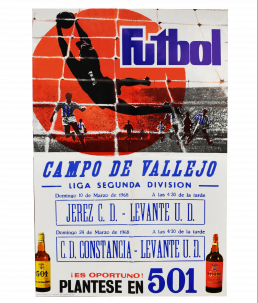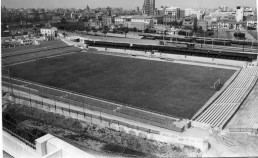It was donated by Ernesto Lapiedra. Perhaps the most striking feature of the poster is its impeccable state of preservation, despite the fact that more than fifty years separate the present from the present. There are no traces of the passing of the calendar, despite the remoteness of its leaves. In the image, perhaps in an unexpected wink to its owner, the acrobatic figure of an archer saving the leather stands out powerfully. The imaginary goal net frames the action.
Lapiedra defended the blue and white goal for Levante’s first team in the clarity of the seventies. At that time Ernesto was competing as a member of the Atlético Levante ranks on the threshold of the Third Division. In his roadmap as a player in the lower categories of the blues and reds squad, there are countless experiences in the Vallejo framework. Lapiedra has guarded this document over the last decades to bequeath it to the militant Levante supporters of the present.
Vallejo opened its doors at the end of November 1925 with a duel between Gimnástico and Atlético Saguntino in the Regional Championship. The opening match was truly overwhelming (6-0). The leaders of the oldest club in the city of Valencia leased some land belonging to the Vallejo Morand family on the other side of the River Turia to accommodate the institution’s football representation. It was the beginning of a relationship that lasted until the end of the sixties. At that point in time, Gimnástico was an indelible reminder of the birth and roots of football in the capital of Turia. In August 1939 Gimnástico and Levante joined forces to form Levante U.D., although in the two seasons following the merger the new club competed under the acronym UDLG (Unión Deportiva Levante-Gimnástico).
In March 1968, Levante had serious existential doubts about the Silver Division. At the end of the league season, the division underwent a process of reconversion. The two groups that had made up the Second Division since the end of the 1940s were reduced to one. This measure, sponsored by the Royal Spanish Football Federation, meant an added drama for countless institutions that would lose their role as teams linked to the second tier of football. The restriction was severe given the number of teams involved. The drama of relegation loomed over Levante. Álvaro took over from Morera on the bench. Nerves took over society. These were important days in the club’s decision-making. The return of Antonio Román to the presidency greatly speeded up the process of building a new sports facility that would exonerate the old Vallejo. The contours of the current Ciutat de València were beginning to take shape.
Jerez and Constancia established the countdown of the competition. The sporting sequence marked the last days of the Estadio de Vallejo. The regularity championship was drawing to a close. Levante had lost the victory in their visit to Mestalla to face the Valencia reserve team (2-0). They failed to redeem themselves against Jerez (1-1). History repeated itself weeks later in the match against Constancia. The Granota team copied the scoreline (1-1). In the next match, they tasted the bitter taste of defeat against Recreativo in Huelva (2-0). Levante slipped down the general classification. And the number of relegations increased due to the decision taken by the federation. May closed the regularity tournament. On the fifteenth of May 1968, Levante and Murcia faced a crucial match. Serafín, one of the heroes of the historic promotion to Primera, whipped Mut’s nets. The draw (2-2) left Levante on the brink of the abyss. The defeat against Calvo Sotelo in Puertollano (2-0) confirmed the bad omens. The victory against Tenerife (1-0) in Vallejo’s farewell match was as sad as it was testimonial.

